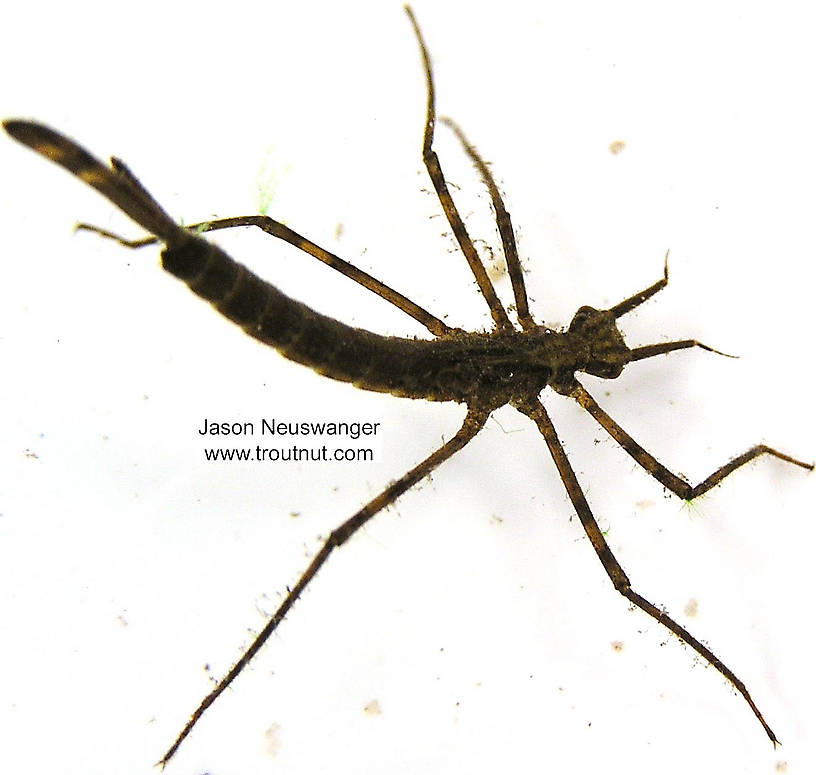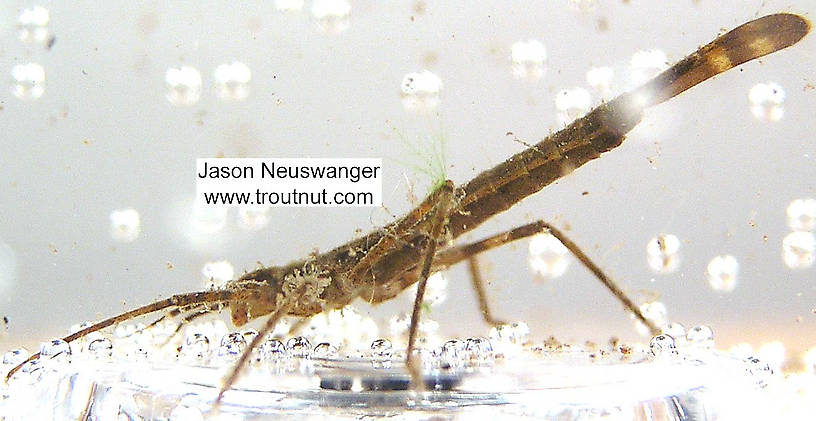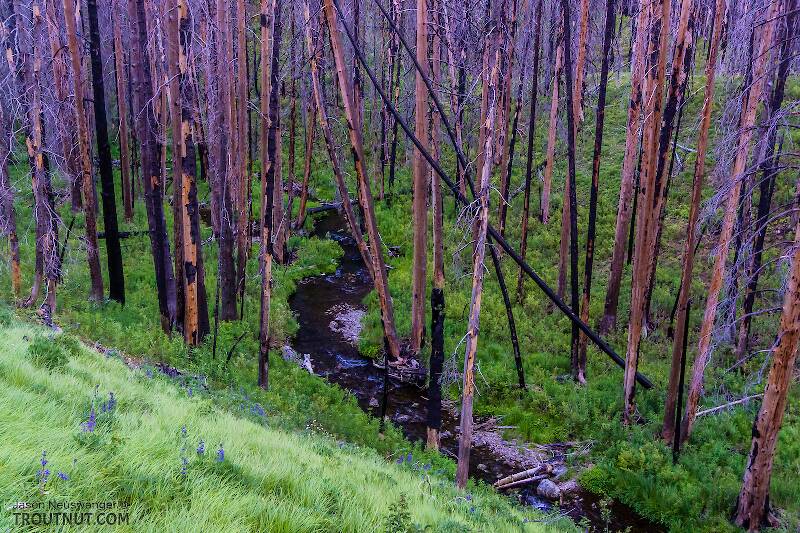
Blue-winged Olives
Baetis
Tiny Baetis mayflies are perhaps the most commonly encountered and imitated by anglers on all American trout streams due to their great abundance, widespread distribution, and trout-friendly emergence habits.
Featured on the forum

It's only barely visible in one of my pictures, but I confirmed under the microscope that this one has a prosternal horn and the antennae are mid-way between the eyes and front of the head capsule.
I'm calling this one Pycnopsyche, but it's a bit perplexing. It seems to key definitively to at least Couplet 8 of the Key to Genera of Limnephilidae Larvae. That narrows it down to three genera, and the case seems wrong for the other two. The case looks right for Pycnopsyche, and it fits one of the key characteristics: "Abdominal sternum II without chloride epithelium and abdominal segment IX with only single seta on each side of dorsal sclerite." However, the characteristic "metanotal sa1 sclerites not fused, although often contiguous" does not seem to fit well. Those sclerites sure look fused to me, although I can make out a thin groove in the touching halves in the anterior half under the microscope. Perhaps this is a regional variation.
The only species of Pycnopsyche documented in Washington state is Pycnopsyche guttifera, and the colors and markings around the head of this specimen seem to match very well a specimen of that species from Massachusetts on Bugguide. So I am placing it in that species for now.
Whatever species this is, I photographed another specimen of seemingly the same species from the same spot a couple months later.
I'm calling this one Pycnopsyche, but it's a bit perplexing. It seems to key definitively to at least Couplet 8 of the Key to Genera of Limnephilidae Larvae. That narrows it down to three genera, and the case seems wrong for the other two. The case looks right for Pycnopsyche, and it fits one of the key characteristics: "Abdominal sternum II without chloride epithelium and abdominal segment IX with only single seta on each side of dorsal sclerite." However, the characteristic "metanotal sa1 sclerites not fused, although often contiguous" does not seem to fit well. Those sclerites sure look fused to me, although I can make out a thin groove in the touching halves in the anterior half under the microscope. Perhaps this is a regional variation.
The only species of Pycnopsyche documented in Washington state is Pycnopsyche guttifera, and the colors and markings around the head of this specimen seem to match very well a specimen of that species from Massachusetts on Bugguide. So I am placing it in that species for now.
Whatever species this is, I photographed another specimen of seemingly the same species from the same spot a couple months later.

Troutnut is a project started in 2003 by salmonid ecologist Jason "Troutnut" Neuswanger to help anglers and
fly tyers unabashedly embrace the entomological side of the sport. Learn more about Troutnut or
support the project for an enhanced experience here.
Calopteryx Damselfly Nymph Pictures




Video Clip
Damselfly Nymph on the Prowl
Damselfly nymphs are among the most effective invertebrate predators in freshwater. You have to see one in motion to get a feel for their slow, deliberate style of stalking.
Featuring: Calopteryx Damselfly Nymph
This damselfly was collected from unknown in Wisconsin on January 31st, 2004 and added to Troutnut.com by Troutnut on January 25th, 2006.
Discussions of this Nymph
Slim and Sparse
Posted by Waxsmith on Mar 18, 2012
Last reply on Mar 18, 2012 by Waxsmith
I have diddled and fiddled to produce decent damsel nymphs for some time now and it is tough to come with up something good either impressionistic or realistic. The one thought, when I watch them move in their environment,is always that they are very sparse predators. So whatever I tie, and it always seems to be an improvement over previous productions, is something slim. Good thing fish often are not too fussy.
Greetings, A.K.
Greetings, A.K.
Another one...
1 replies
Posted by DMM on Jan 19, 2007
Last reply on Jan 20, 2007 by Martinlf
Calopteryx
These are beautiful as adults. Wherever you get these, you should go back when they are emerging. Alternatively, keep them in your aquarium until they emerge. They're easy enough to keep...except when you have Aeshna with them...
These are beautiful as adults. Wherever you get these, you should go back when they are emerging. Alternatively, keep them in your aquarium until they emerge. They're easy enough to keep...except when you have Aeshna with them...
Start a Discussion of Nymph
Calopteryx Damselfly Nymph Pictures
Collection details
Location: unknown, Wisconsin
Date: January 31st, 2004
Added to site: January 25th, 2006
Author: Troutnut
Date: January 31st, 2004
Added to site: January 25th, 2006
Author: Troutnut

